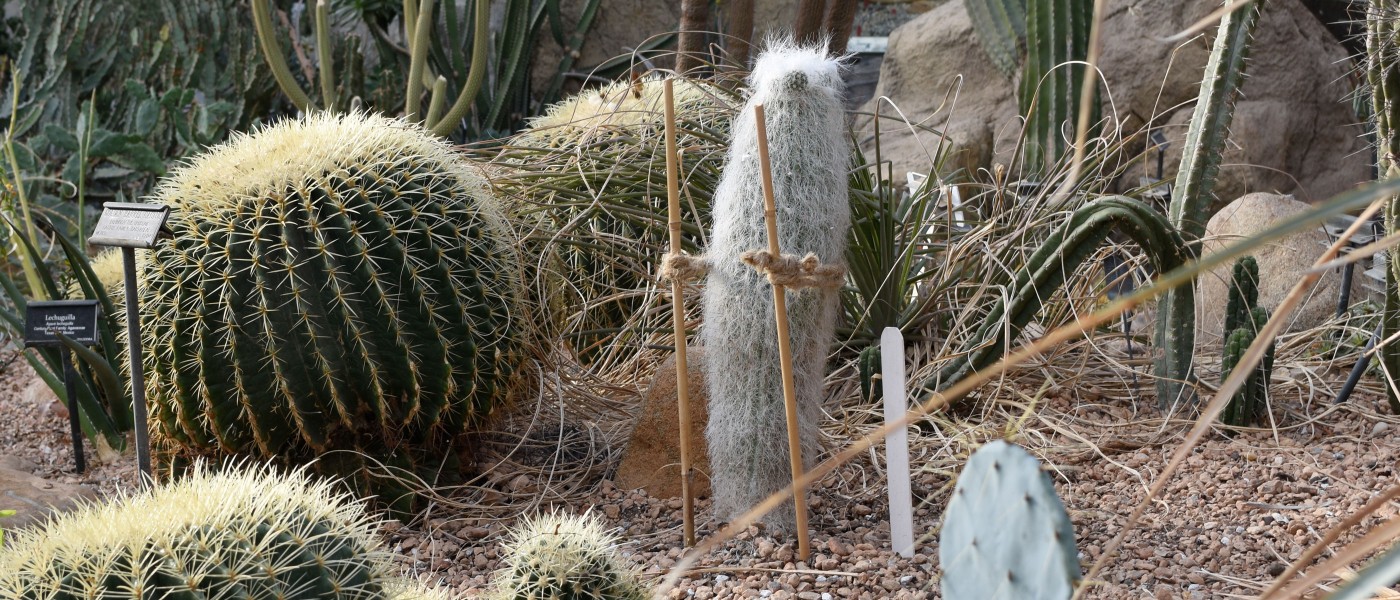Look for These Cacti and Other Plants in the Desert Pavilion
The Desert Pavilion is filled with interesting plants year-round. "In winter, aloes, euphorbias, and many other plants native the southern hemisphere begin to flower. Then, as our spring approaches and the days lengthen, many other desert plants begin to grow and bloom," says curator Caitlin Daley.
All the plants here are native to arid regions and have adapted to that harsh climate in all sorts of interesting ways. Many are cacti with modified, spiny leaves and fleshy, succulent stems that hold water, but there are other plants with adaptations you may not be so familiar with. Here are a few highlights to see right now!
Old-Man Cactus
Cephalocereus senilis
This common houseplant is native to Hidalgo, Mexico and endangered in its natural habitat. Its name comes from its white hairs, which are modified spines that help protect the plant from extreme sun and cold. Daley added wooden stakes and rope to help support this newly planted specimen. If they make the plant seem a little more anthropomorphic, that’s just a coincidence!
Melon Cactus
Melocactus intortus
The Garden received a collection of these round cacti from the USDA Plant Rescue Center Program (PDF) after they were confiscated by U.S. Fish and Wildlife for being illegally collected. Their exact provenance isn’t known, but the species is native to the Caribbean and found along coasts. One clue: Daley found seaweed intertwined with the plants’ roots, so likely they were taken from a beach. The specimens on display are relatively young. When they reach maturity, the spherical part stops growing and then produces a long, reddish flower structure.
Texas False Agave
Hechtia texensis
This Texas native looks a lot like an agave, but it’s actually a bromeliad, so it’s more closely related to the pineapple. These tough plants do not hold water in their tissue like a true succulent, says Daley. They will slow their growth when water is unnavailable, and their whorled, spiny leaves, along with their root system, help them to collect whatever water they can.
Blue Paloverde
Parkinsonia florida
The common name for this tree means “green stick” in Spanish, a reference to its bluish-green trunk. During droughts, the plant drops its leaves to preserve energy, but the branches and trunk contain chlorophyll and can continue to perform photosynthesis.
Cochineal-Plant
Opuntia cochenillifera
This large tree cactus is remarkably old for its species—it was given to BBG by New York Botanical Garden in 1916. The species is native to Mexico and has naturalized to the West Indies and parts of Central and South America. It’s just now starting to flower—over the summer, the plant will flower more and also to produce new pads. The cochineal-plant is a host plant for the cochineal insect, and at one point it was widely cultivated to attract them for use in natural dyes.


